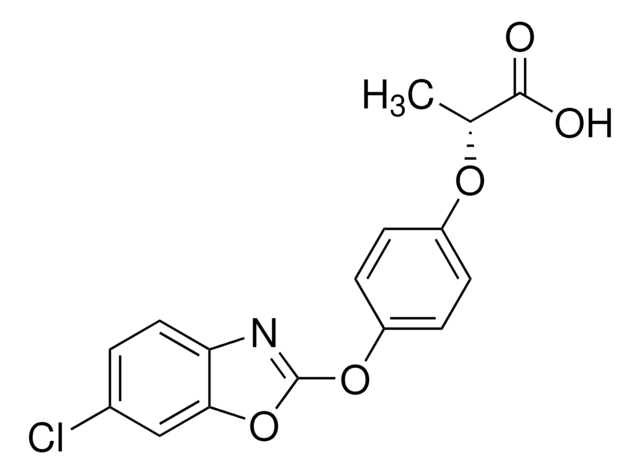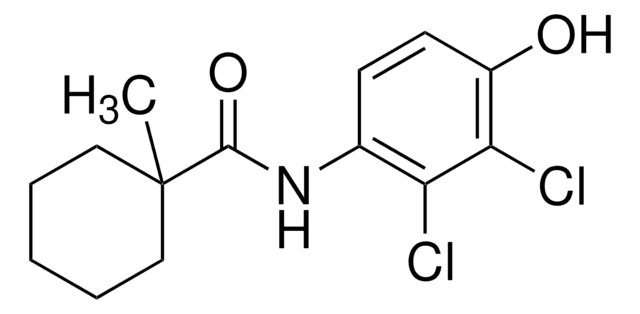36849
Fenoxaprop
PESTANAL®, analytical standard
Sinonimo/i:
2-{4-[(6-Chlorobenzoxazol-2-yl)oxy]phenoxy}propionic acid
About This Item
Prodotti consigliati
Grado
analytical standard
Livello qualitativo
Nome Commerciale
PESTANAL®
Durata
limited shelf life, expiry date on the label
tecniche
HPLC: suitable
gas chromatography (GC): suitable
applicazioni
agriculture
environmental
Formato
neat
Temperatura di conservazione
2-8°C
Stringa SMILE
CC(Oc1ccc(Oc2nc3ccc(Cl)cc3o2)cc1)C(O)=O
InChI
1S/C16H12ClNO5/c1-9(15(19)20)21-11-3-5-12(6-4-11)22-16-18-13-7-2-10(17)8-14(13)23-16/h2-9H,1H3,(H,19,20)
MPPOHAUSNPTFAJ-UHFFFAOYSA-N
Cerchi prodotti simili? Visita Guida al confronto tra prodotti
Descrizione generale
According to Commission Regulation (1107/2009), fenoxaprop is not approved for use as a plant protection product in the European Union. However, a default MRL of 0.01 mg/kg is set according to Art 18(1)(b) Reg 396 / 2005.
Applicazioni
- Develop an HPLC method for the determination of fenoxaprop-ethyl and fenoxaprop residues in four soil types using two extraction procedures
- Validate the resistance of fenoxaprop in wild oats in Turkey and investigate cross and multiple resistance patterns of fenoxaprop-resistant wild oat populations
- Investigate the degradation of fenoxaprop-ethyl and fenoxaprop in three soils were under native and sterilized conditions using enantioselective high-performance liquid chromatography (HPLC)
- Determine the effect of soil moisture, temperature, and light intensity on the spray deposition of fenoxaprop and imazamethabenz applied to wild oat plants
- Investigate and quantify the resistance of Japanese foxtail (Alopecurus japonicus) to fenoxaprop and pinoxaden in China and elucidate the basis of resistance to these herbicides
Note legali
Avvertenze
Warning
Indicazioni di pericolo
Consigli di prudenza
Classi di pericolo
Aquatic Acute 1 - Aquatic Chronic 1
Codice della classe di stoccaggio
11 - Combustible Solids
Classe di pericolosità dell'acqua (WGK)
WGK 3
Dispositivi di protezione individuale
Eyeshields, Gloves, type N95 (US)
Scegli una delle versioni più recenti:
Certificati d'analisi (COA)
Non trovi la versione di tuo interesse?
Se hai bisogno di una versione specifica, puoi cercare il certificato tramite il numero di lotto.
Possiedi già questo prodotto?
I documenti relativi ai prodotti acquistati recentemente sono disponibili nell’Archivio dei documenti.
Filtri attivi
Il team dei nostri ricercatori vanta grande esperienza in tutte le aree della ricerca quali Life Science, scienza dei materiali, sintesi chimica, cromatografia, discipline analitiche, ecc..
Contatta l'Assistenza Tecnica.









